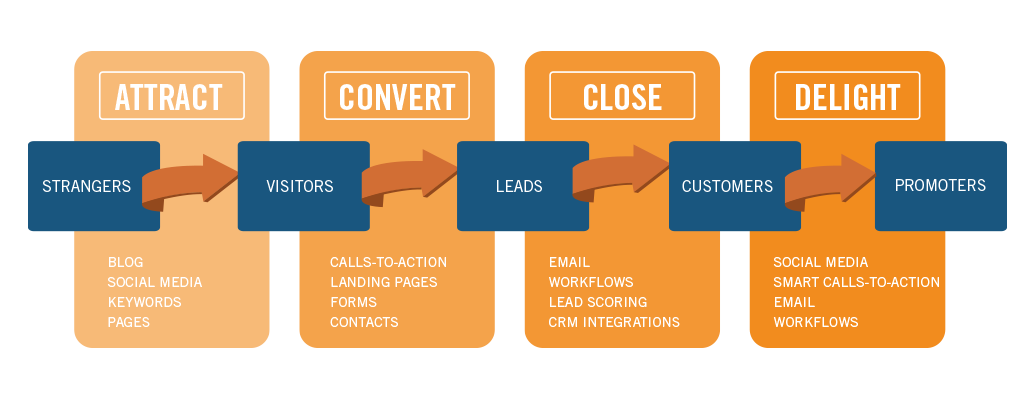I specialize in working with financial advisors using a strategy called inbound marketing to attract and retain clients. The term inbound marketing refers to marketing activities that attract the right audience, rather than pushing unwanted messaging toward the wrong audience while hoping to gain their attention. Inbound marketing earns the attention of the right potential customers, makes the company easy to be found, and draws customers to the website by leveraging the company’s expertise to create valuable content.
Instead of the old “outbound marketing” methods of buying ads, buying email lists, and praying for leads, inbound marketing focuses on creating quality content that pulls people toward your company and product, where they naturally want to be. It’s also the most efficient and cost effective way to connect in a world where customers have unlimited choices and own all of the purchasing power.

Digital Marketing Services
Here are the services that I offer to help you grow your business.
Search Engine Optimization
For the majority of small and medium-sized businesses, a large amount of traffic that you’ll receive on your website and other online channels will often come from search engines. The majority of this traffic will come from Google, which is the leader among search engines by a wide margin.
What is search engine optimization? I think a better question is, “What is optimization as it relates to search engines?” What it isn’t is search engine marketing. That term is often used along with search engine optimization as though the two are interchangeable. However, in my opinion, there is no such thing as search engine marketing.
So if Google’s purpose is to provide the most relevant articles and the best results on each search for each consumer, then it’s your job to give Google whatever it needs so that your information and your expertise is available to them. That doesn’t mean you will be creating content and writing articles specifically for Google. But it does mean that you’ll be aware of the specific priorities and recommendations that Google makes so they can access your articles and information quickly and efficiently. Then when a search engine crawls your site, your content can appear for the appropriate search query in their search results.
Demand Generation, Lead Generation & Lead Nurturing
The ultimate goal of every business website is to grow your business. To help clients accomplish, I focus on three primary components – demand generation, lead generation and lead nurturing. With a solid system in place, these three components will find, attract and convert visitors into customers and into raving fans.
Demand generation means creating awareness of a problem, need or challenge in the marketplace. You’re looking to enlighten an audience to a current or potential issue for which you have a solution.
The goal of lead generation through digital marketing is to find relevant potential customers who could benefit from your product or service. Attracting the wrong audience isn’t helpful, and therefore from the outset the focus should be on relevant potential customers.
Lead nurturing is the process of growing and building relationships with potential clients no matter what stage they are at in their customer journey. With digital lead nurturing, we’re at a point where that one-to-one relationship can be closely replicated. It’s a significant advantage to have solid lead nurturing programs in place where you can retain contacts that may not be at the right stage of their buying cycle, and work to improve your relationship with them.
Today’s technology has drastically changed what can be accomplished through digital marketing nurturing campaigns. The disparity between the companies that use lead nurturing versus those that don’t is getting larger, as the organizations that learn how to leverage this tool are rapidly grabbing market share while their competitors are left in their wake.
Content Marketing
The term “content marketing” could be considered somewhat repetitive because practically all marketing involves content. In reality, content marketing or “inbound marketing” has been around for over a century in one form or another, practiced by all kinds of businesses.
So why is content marketing so popular now, since it’s been around for so long? Well, the first reason is that if you’re not producing content in the digital era, you’ll be drowned out by your competition. It’s that simple. The audience is there and your competitors are probably there; and if they’re not, they will be. In today’s information age, content is king.
The first step of all business relationships is sharing some form of expertise. Whether you’re visiting a bricks-and-mortar store, speaking over the phone, or communicating via email, a customer will reach out to a company for information relevant to their needs. In today’s digital world, it’s now your job to be one step ahead and reach out to your potential customers with helpful information around your expertise.
Email Marketing
Despite the advent of numerous new marketing channels and opportunities, email marketing is often still a preferred method of communication for most business relationships. From a small and medium-sized business perspective, email is highly cost effective, as compared to other types of direct mail or similar one-to-one correspondence.
Another benefit of email is that it’s easily trackable. With email marketing, you receive campaign results instantly, allowing you to make decisions and adjustments on the fly and without the need for additional resources.
The key driver to success using email marketing is relevancy, which means providing the right message to the audience that’s looking for it. Your goal when sending email is to target either a person, or a persona, and give them information that they’ve requested or could use. This will help eliminate unnecessary emails, and improve your overall relationship with your customers and potential customers.
Website Design & Development
With nearly 20 years of experience in web development and graphic design, I’ve created 100+ websites across nearly every available platform. Your site needs to be built for real people, with highly functional navigation and optimized for search engines.
Over the past five years, most of the website that I’ve built have been with the open source WordPress content management system. In 2014, nearly 22 percent of all websites were built using WordPress, according to Web Technology Surveys. WordPress owns a 60 percent share of the content management system market, followed by Joomla (9 percent) and Drupal (5 percent). Currently, 36 percent of all websites are built using a content management system.
WordPress can be customized and built into your own look and feel by using themes which are pre-built that you can modify. A positive element of using a content management system, especially an open source content management system, is that you have the power of thousands of people working together to build, manage, and improve the software.
Social Media Marketing
I like to use the analogy of a food truck to describe the opportunity available through social media marketing. If you own a food truck, it’s your job to sync your menu with the audience that you’ll be visiting. Consequently, if your culinary specialties involve a lot of meat products, you’re not going to want to drive your truck into a neighborhood populated by vegetarians.
The same philosophy applies with social media channels. The audience is different for each channel, meaning you’ll decide to park your truck there depending upon whether they’re a good potential audience for your product or service. That means it’s essential for the your business to identify where you might be able to reach the relevant audience.
The primary benefit of social media marketing is that you can efficiently build your audience by reaching new potential customers. You may not own this new contact directly at first, but you can certainly create awareness and take steps to transfer your new relationships into a different environment where you’ll have more control.
Digital Advertising
The world of digital advertising has changed drastically over the past few years. The options available and the ability to track, test, and improve responses have definitely enhanced the opportunity for advertisers to reach their target audience using digital channels.
Sponsored search is a primary digital advertising channel that typically draws the lion’s share of revenue for search providers such as Google and Bing. Sponsored search ads are promotions that appear next to the organic results for a relevant keyword search phrase.
Social media marketing has evolved into a powerhouse digital advertising platform. Certainly the massive audiences that social media channels have attracted make an obvious target for advertisers wanting to bring their product or service to that audience. The second half of this equation is the fact that the social media channels themselves have become more creative in recent years in terms of ways an advertiser can bring their message to the audience of that social media channel. Sponsored stories, embedded messages, and other tactics are available in addition to traditional text or banner ads opportunities within nearly all social media networks.
Analysis and Conversion Rate Optimization
One of the strengths of digital marketing is the ability to use analytics and data to help manage your marketing and business decisions pragmatically. The key to developing a successful digital analytics program for your business is creating a closed-loop system that allows you to track the impact each digital channel makes on your objective.
A primary benefit of using digital analytics is that it allows you to avoid making assumptions. Having the ability to identify clearly what is happening within your marketing campaigns and then turn that into usable insights can help create efficiencies within your organization. This type of data allows you to quickly identify inefficiencies and improve the overall capabilities of your organization.
With the tools now available for digital analytics, you’re able to see results across all channels, platforms, hardware, and software. What this means is that you can compare and contrast where your efforts and your investment should be going, with the goal of optimizing both elements.
Tracking your results across all sources is a key differentiation between an optimized business and one that is in a set-it-and-forget-it mode. The difference between these two organizations is that one is constantly improving results and lowering costs while the other is continuing to hope for better results while seeing their costs increase.

What’s Your Website Score?
Get your free website audit in less than a minute and see how optimized your website is for an exact keyword or phrase.




